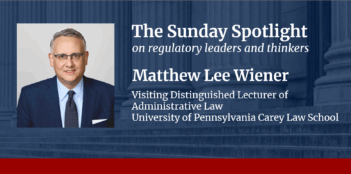
A Penn Program on Regulation panel addresses the implications of overturning the Chevron doctrine.
In June, the U.S. Supreme Court overruled the landmark case Chevron U.S.A. v. Natural Resources Defense Council, which dictated that the courts defer to agencies’ reasonable interpretations of ambiguous statutes. Since Chevron had been handed down in 1984, it had become one of the most cited standards in U.S. administrative law, referenced in over 70 Supreme Court cases and 17,000 lower court cases.
In the wake of the Court’s decision overturning Chevron, both lawyers and the public have asked: What comes next?
This question formed the centerpiece of a Penn Program on Regulation (PPR) panel convened in the immediate aftermath of the Court’s decision in Loper Bright v. Raimondo. Organized and moderated by Neysun Mahboubi, Director of the Penn Project on the Future of U.S.-China Relations and a PPR affiliate, the panel brought together five leading administrative law experts to discuss Chevron’s legacy and the effects of its overruling.
Beginning with reflections from history, panel member Michael Herz, a Cardozo School of Law professor, noted that the Chevron decision did not immediately become the groundbreaking doctrine it came to be known as in more recent decades. Referencing his time clerking at the Supreme Court when it issued Chevron, Herz stated that no one perceived the decision to be “transforming the law.” The decision was even handed down with three justices having recused themselves.
As court decisions cited Chevron with greater frequency, it emerged as a widely accepted standard in administrative law. But Herz observed that Democratic and Republican support for Chevron tended to fluctuate, depending on which party held the White House.
Yet more recently, the Chevron doctrine had become a powerful partisan litmus test in addition to a legal standard. Panel members Cary Coglianese, a Penn Carey Law professor and PPR’s Director, and Emily Bremer, a Notre Dame Law School professor, both emphasized the symbolic import that Chevron had assumed in the legal field.
During the Obama Administration, partisans tended to cement their viewpoints, with Democrats generally in support of Chevron and Republicans generally in deep opposition to it. Strikingly, those positions held once Donald Trump became president. Herz concluded that this reflected a general consensus that, overall and on the whole, Chevron was a pro-regulatory doctrine, both as a symbol and in operation.
Chevron’s symbolic nature may have even influenced the language of the recent Loper Bright decision. Herz highlighted that the Supreme Court’s use of the term “overruled” in its opinion may have been “technically incorrect.”
The Supreme Court abandoned an “interpretive technique” adopted in a previous opinion, which does not align with the traditional conception of overruling a decision. Yet, Herz stated, the word “overruling” carries symbolic and even emotive weight.
The panel’s conversation shifted to the future impact of Loper Bright. The Supreme Court itself described Chevron as a “decaying husk” in its opinion, presumably alluding to the fact that Chevron has held more significance for the lower courts than the Supreme Court for some time. Given the doctrine’s varying interpretations since 1984, discussions about Chevron’s impending “doom” have been circulating among administrative law scholars for years.
Panel member Bridget Dooling, a Moritz School of Law professor, proposed that Loper Bright calls for a more “muscular” form of judging by the lower courts, when previously courts had been instructed to show “humility” to agency decisions and expertise.
Coglianese suggested that Loper Bright’s overruling of Chevron could open a Pandora’s box of litigation over prior court cases that relied on the Chevron doctrine.
Herz expressed interest in the evolution of the federal landscape post-Loper Bright, which he saw as a reflection of anti-administrative sentiment by the Supreme Court, or a representation of diminished trust in agencies.
Panel member Kristin Hickman added that the magnitude of Loper Bright’s impact would largely depend on the actions of agency officials, the courts, and Congress. With Skidmore v. Swift & Co. remaining intact, and “carve-outs” in the new decision for mixed questions of fact and law and express delegations, Loper Bright only modified the standard for deference rather than eliminating it entirely.
In line with this view, several panelists suggested that the courts will never be completely free from the act of deference, a point Hickman once noted in an article entitled, Chevron’s Inevitability.
All panelists agreed that the Court’s decision in Loper Bright and other recent cases make for an interesting time for law students to be studying administrative law. In addition, Mahboubi noted the prominence of Loper Bright and Chevron in public discourse, an uncommon occurrence for most administrative law decisions.
Although the exact impact of Loper Bright on administrative law remains to be seen, the panelists expressed curiosity about its effects, with a wait-and-see approach to assessing what impact it holds for the future of U.S. federal agencies.
In the end, they suggested that Chevron may be dead, but judicial deference to agencies might not be. Indeed, some of the panel members expressed the view that something like Chevron deference will surely survive even if the precise contours of future doctrine remain to be seen.
A video recording of the discussion can be viewed online at PPR’s YouTube channel.



